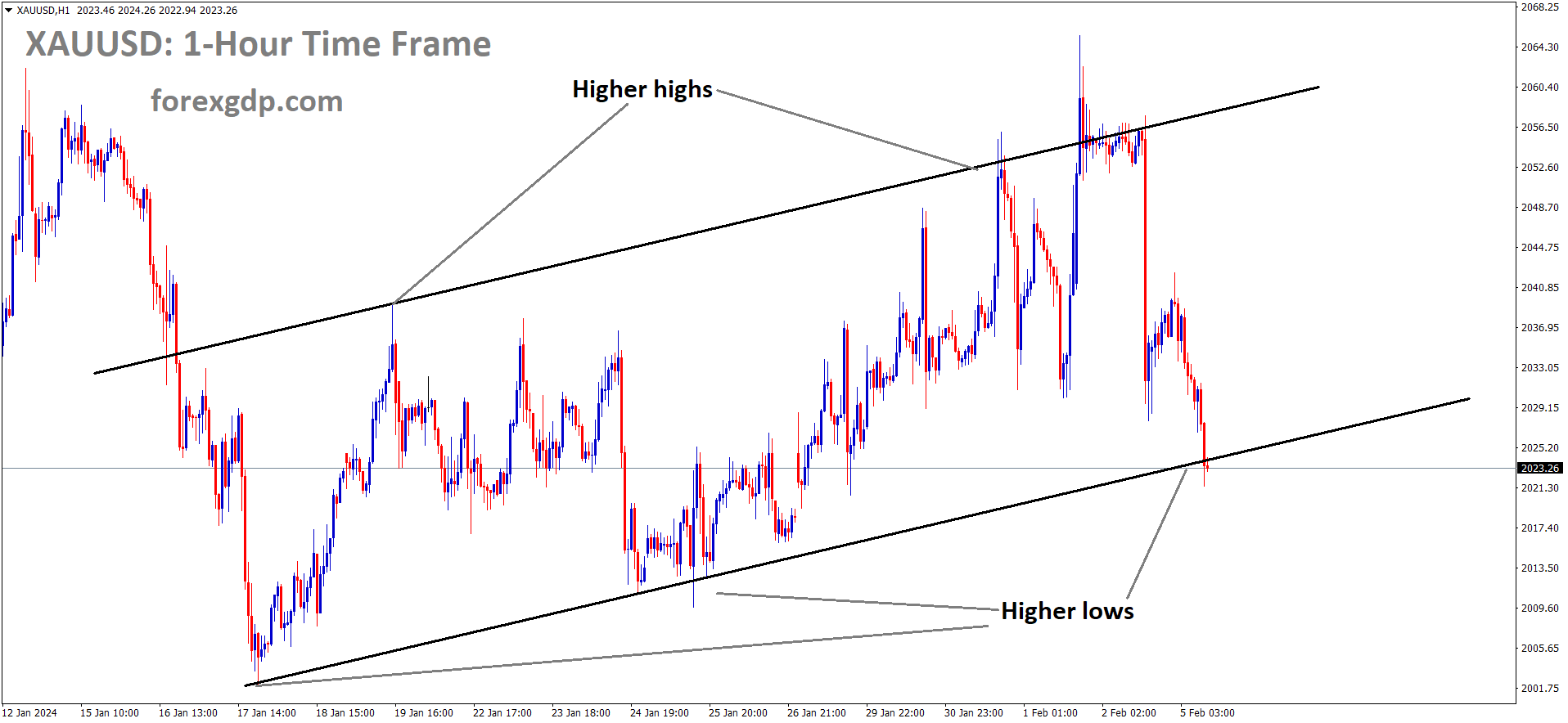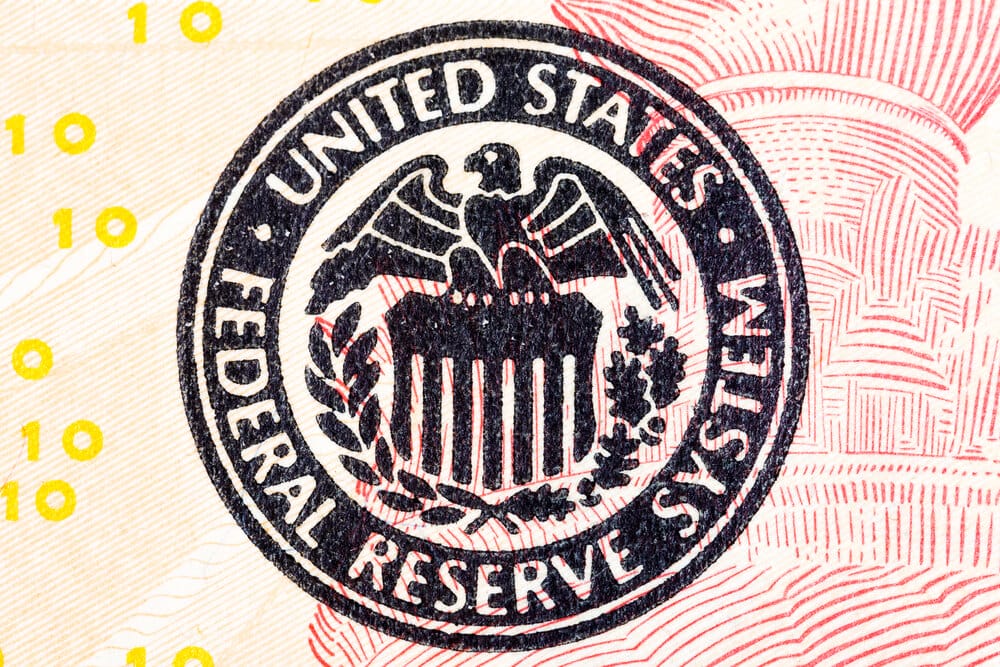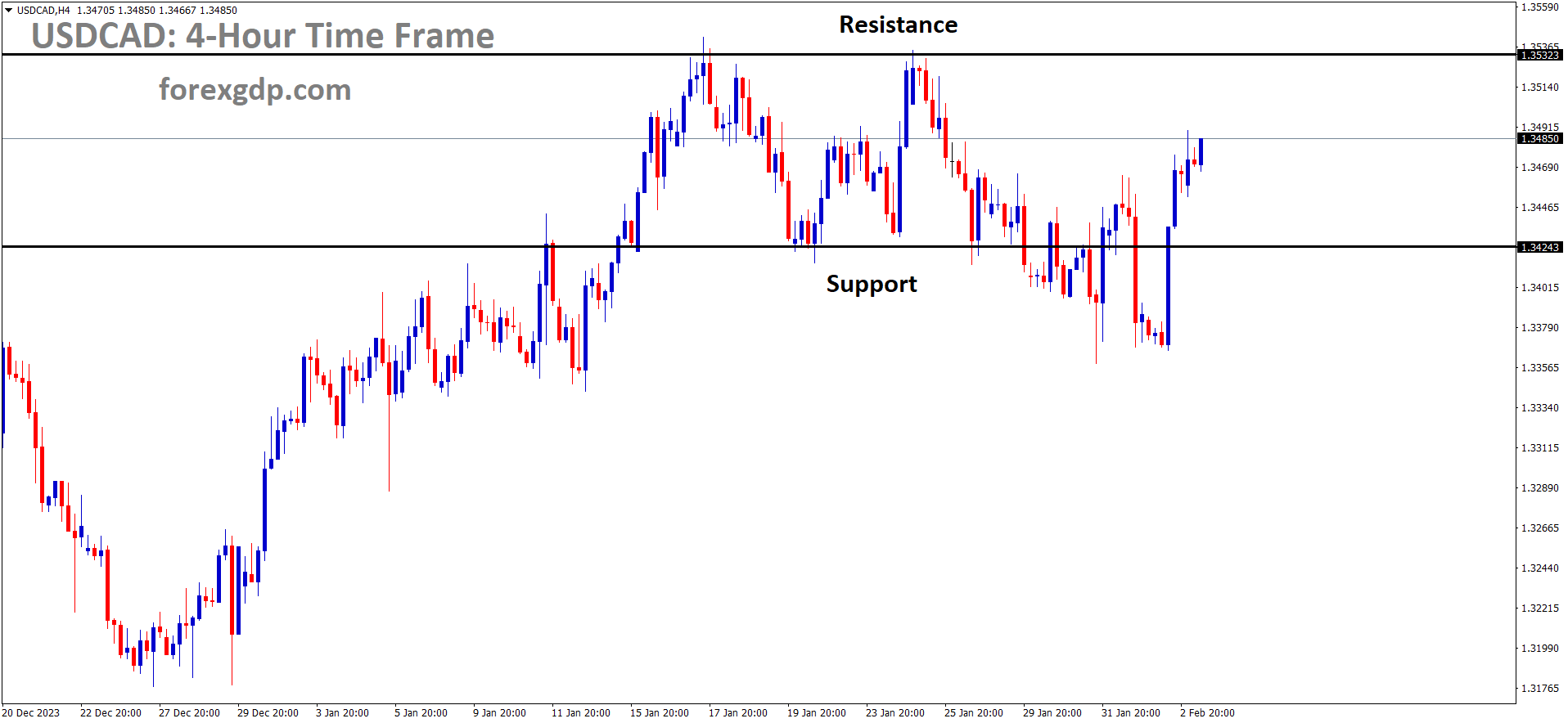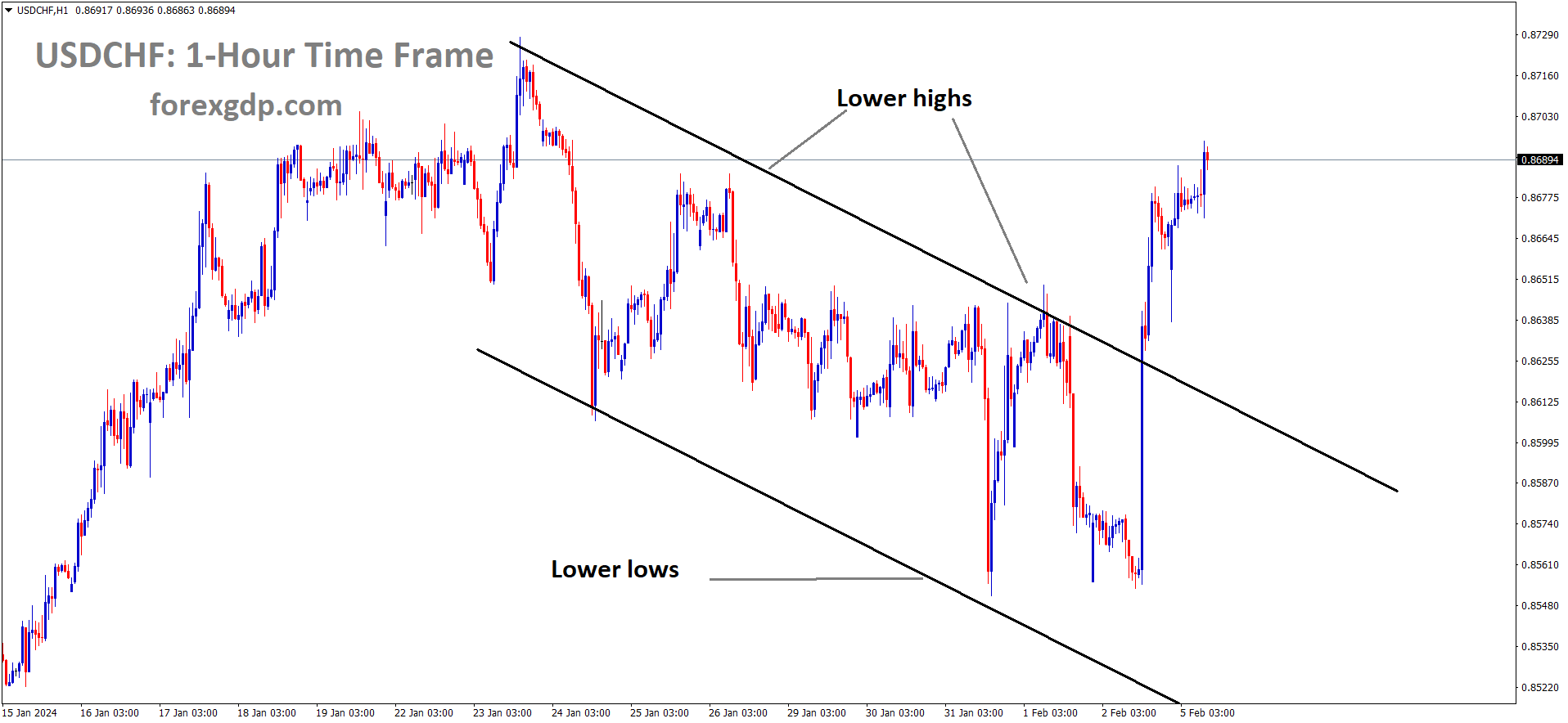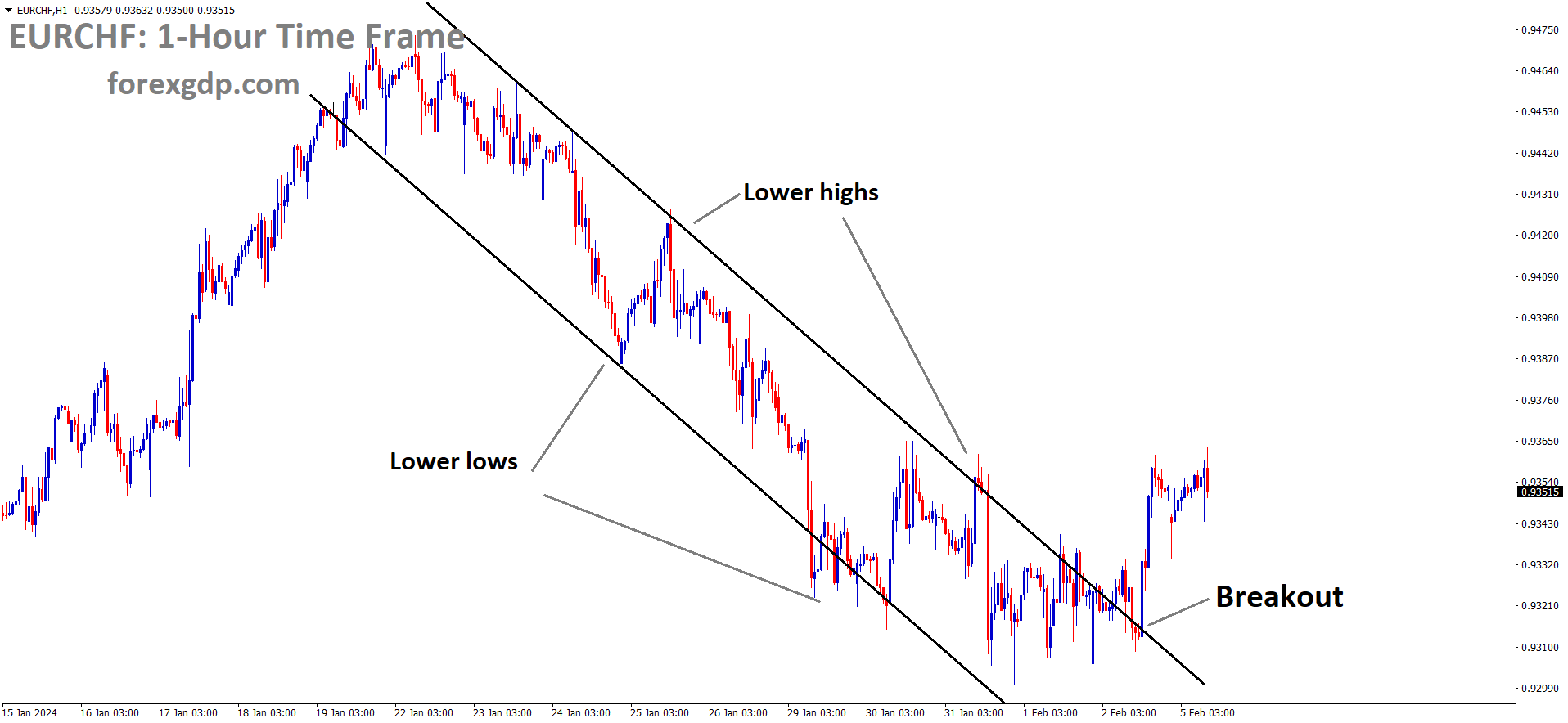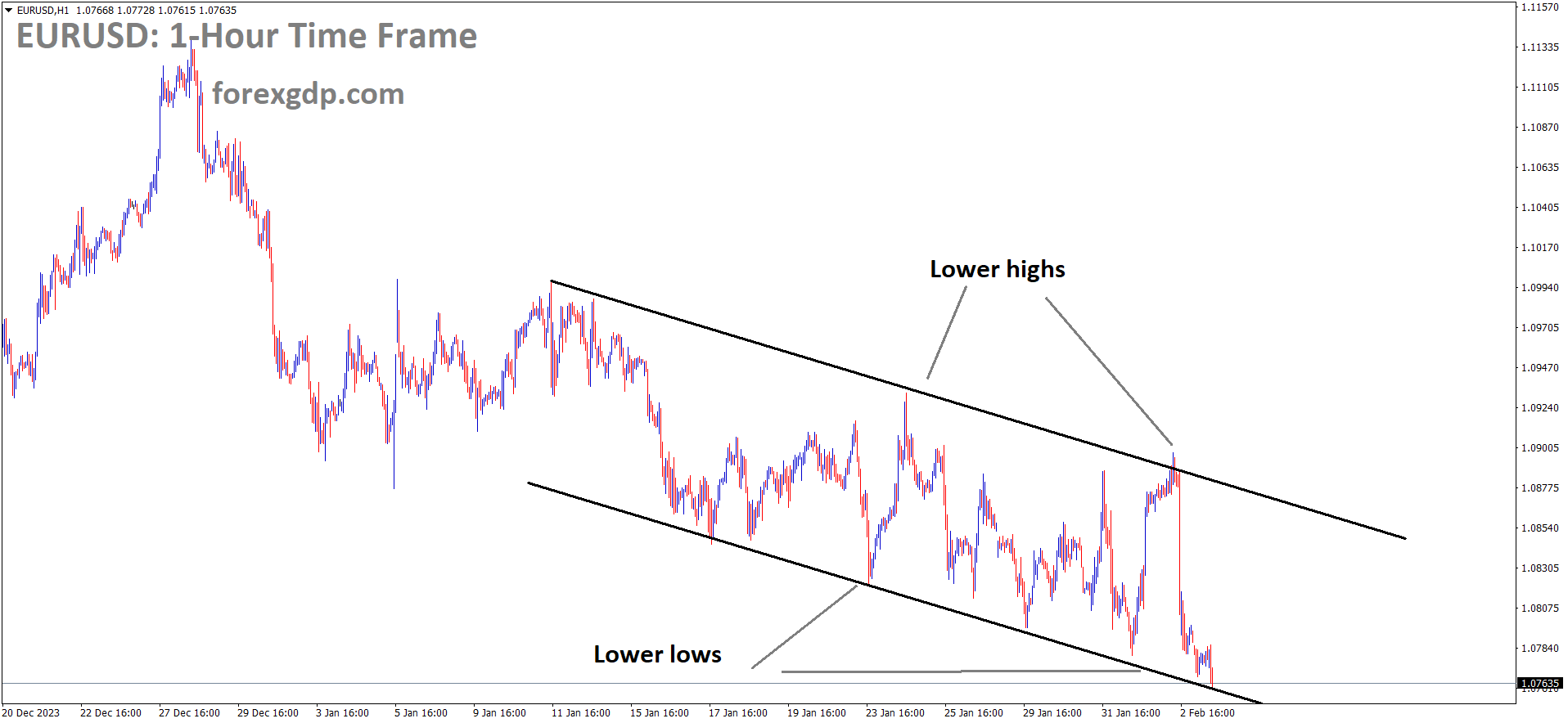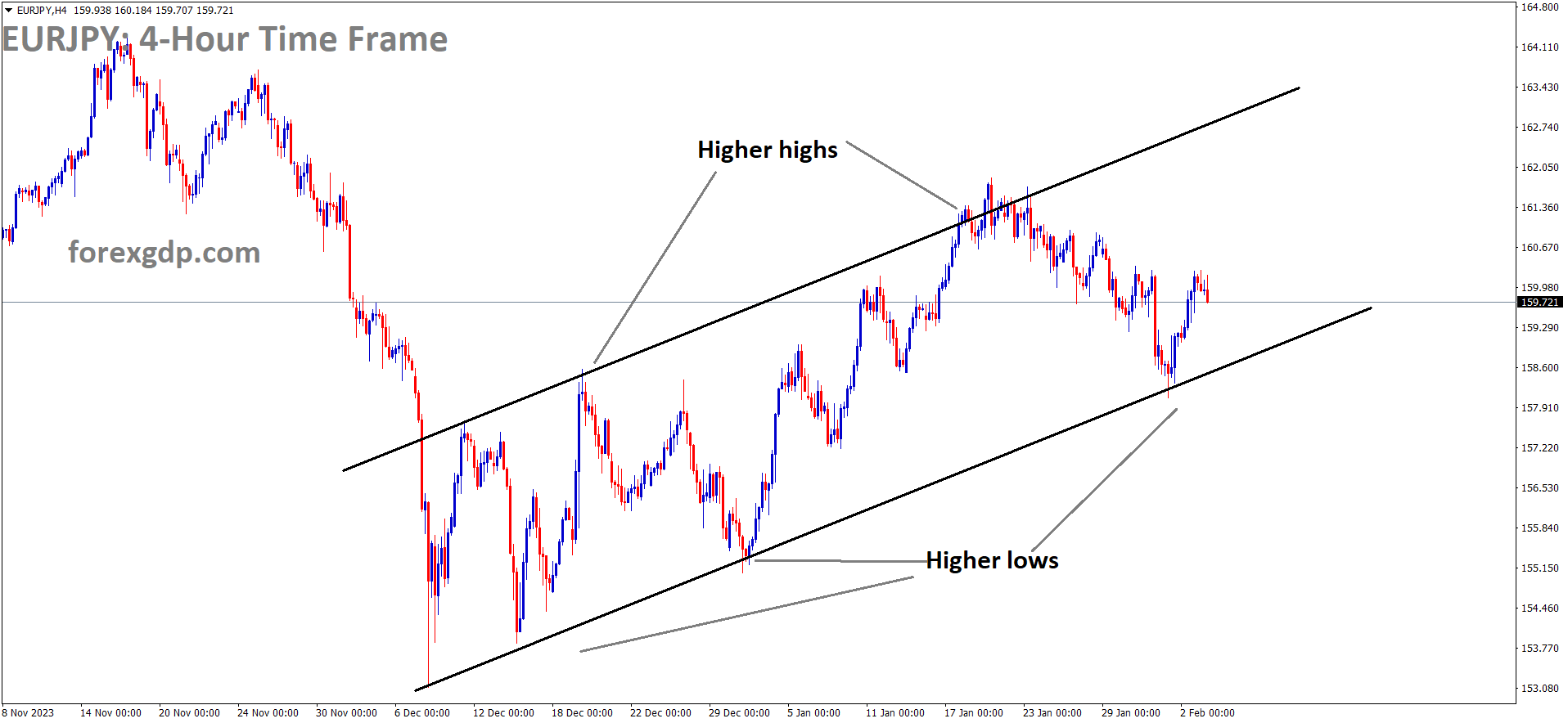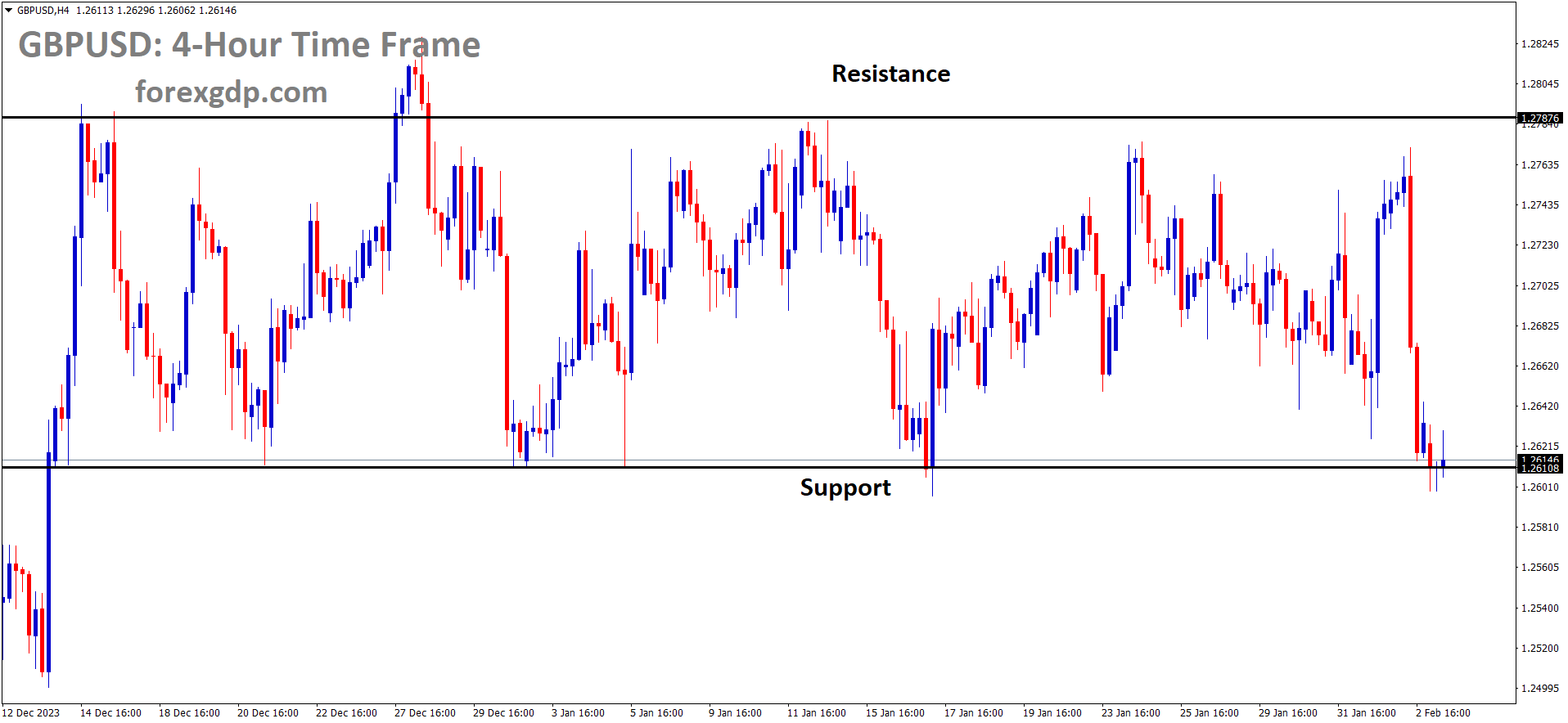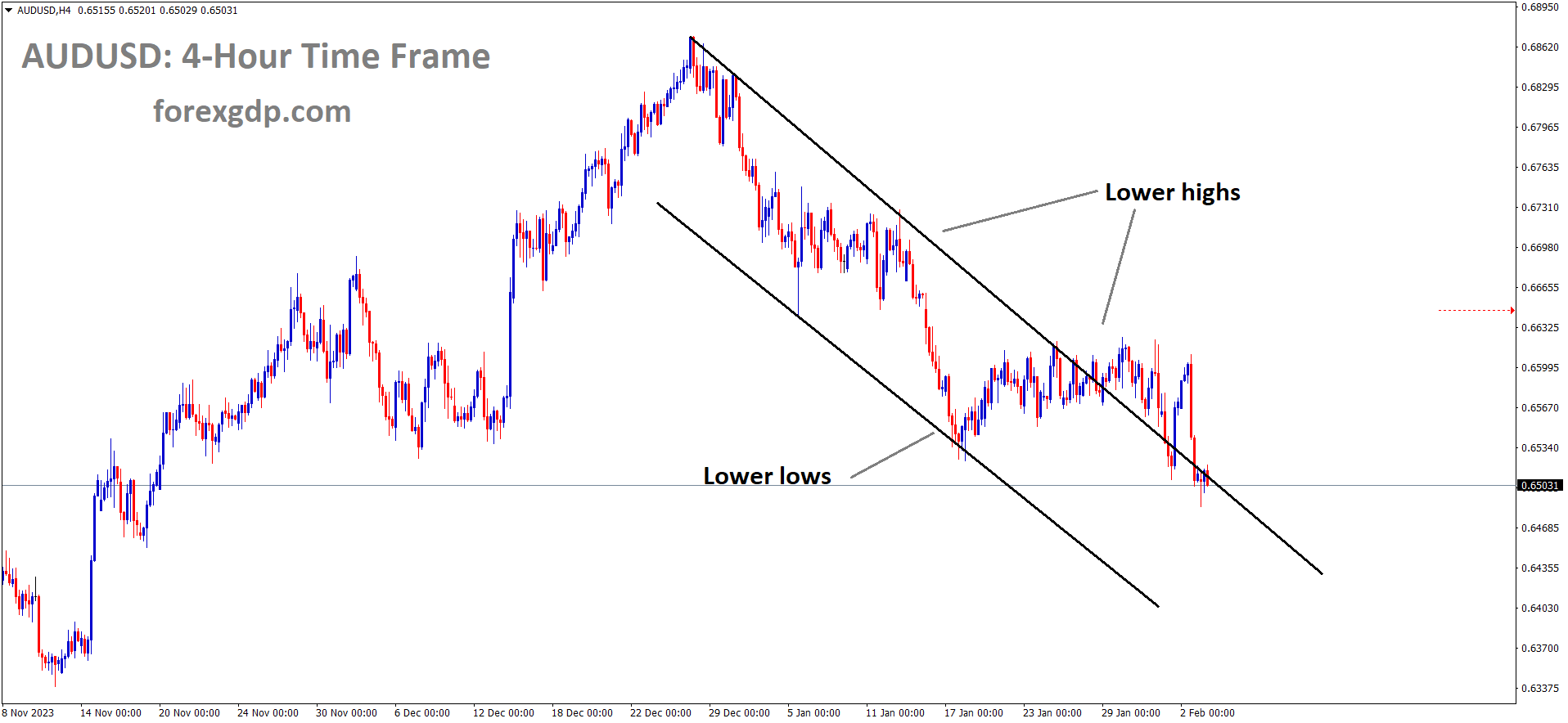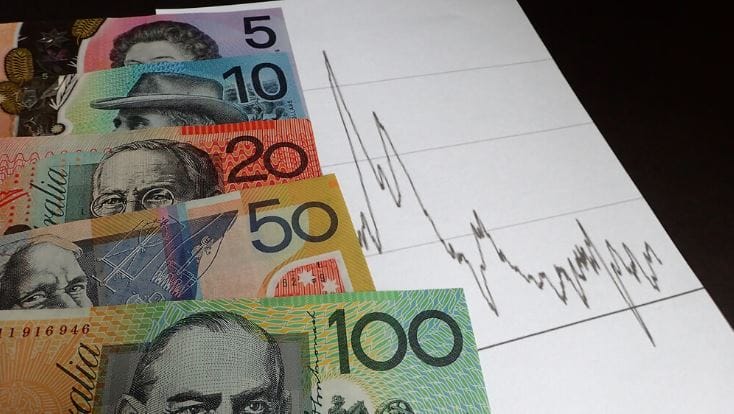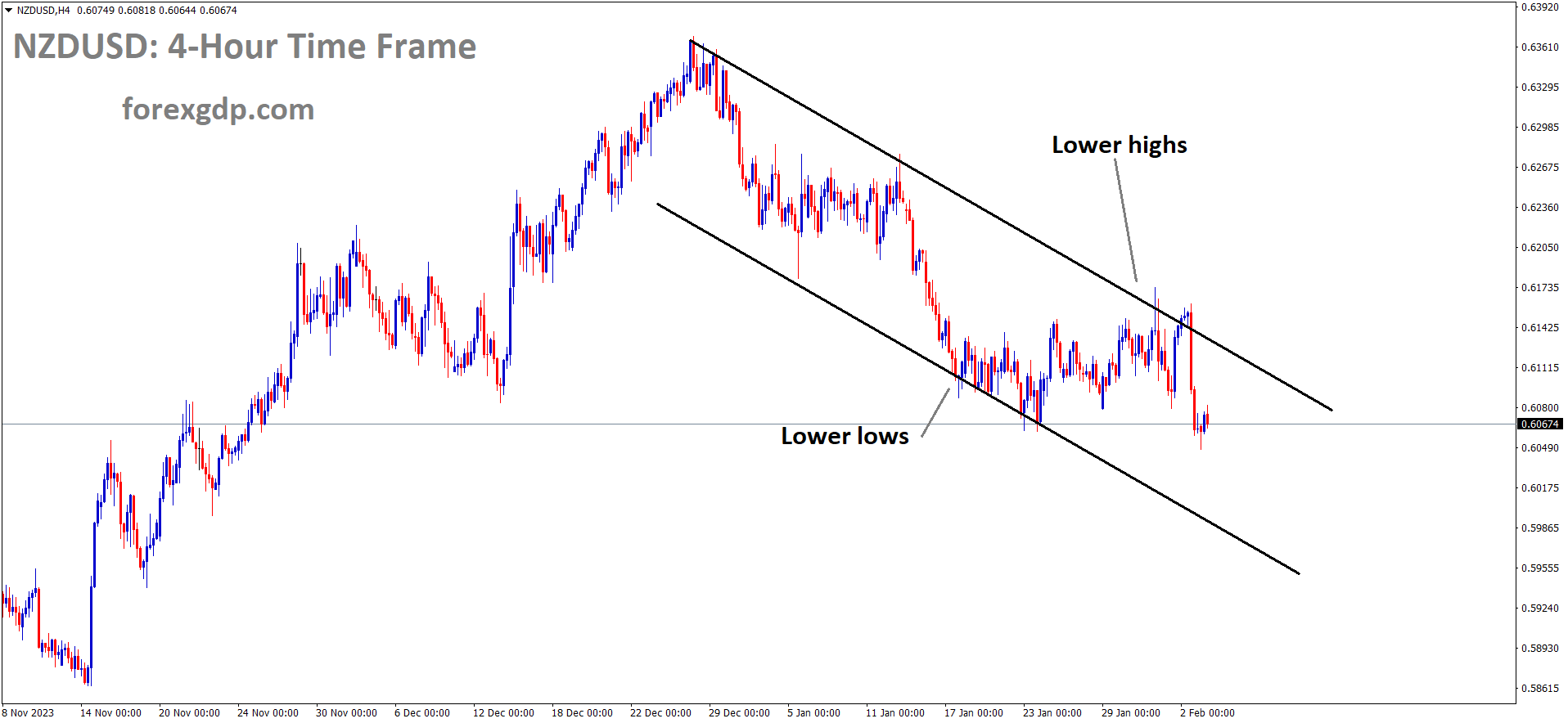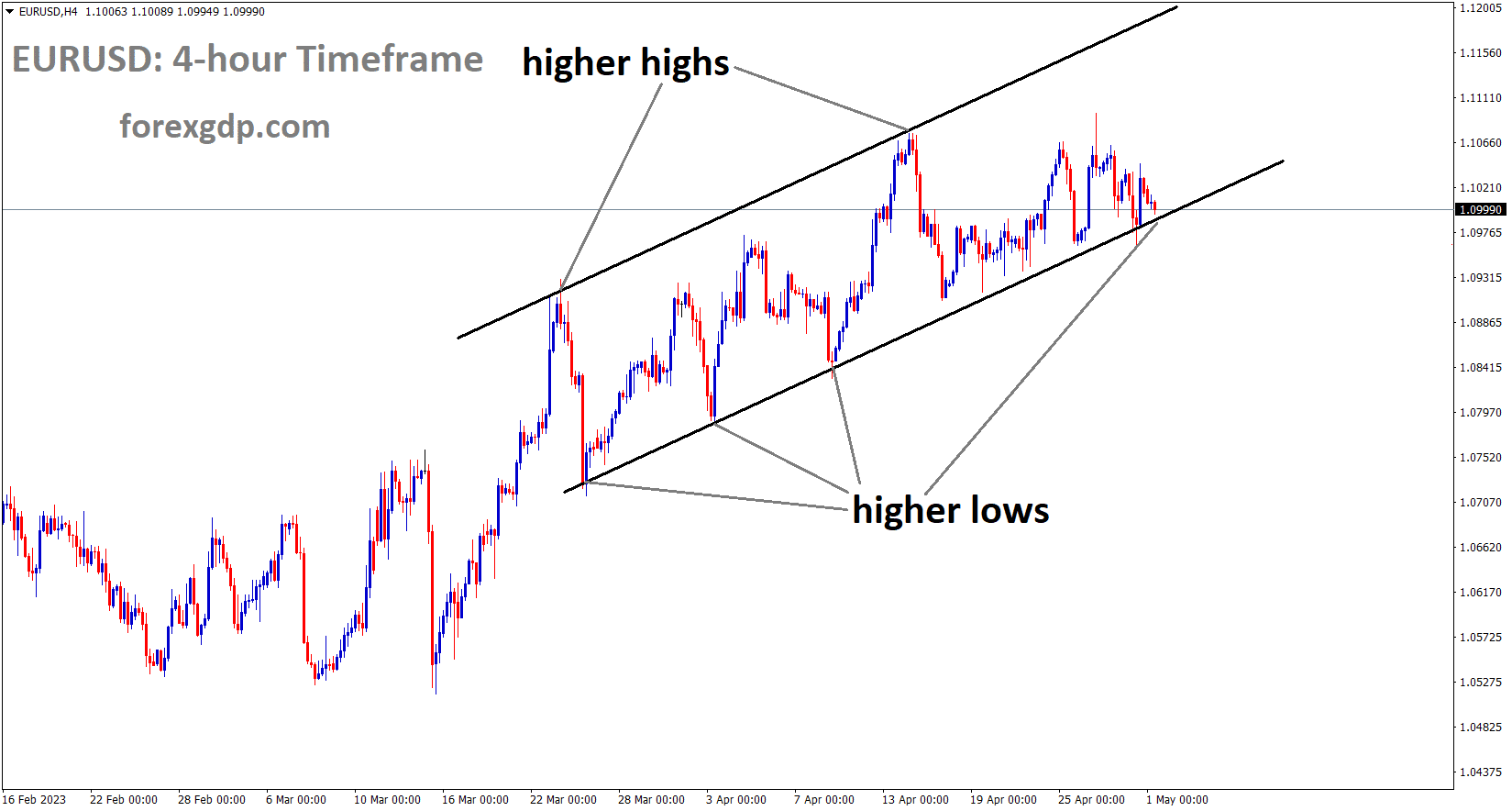GOLD Analysis:
XAUUSD Gold price is moving in an Ascending channel and the market has reached the higher low area of the channel
Gold prices are pressured after the US Employment rate and Jobs data came higher than expected last Friday. Geopolitical tensions surrounding in Red Sea make the US Dollar stronger in the market.
Gold Slides 2nd Day on Dwindling Fed Easing Bets; Geopolitical Risks, China Economic Concerns Offer Support. Gold Faces Selling Pressure, Down 0.30% Around $2,030; Reduced Fed Easing Expectations and Strong US Employment Data Boost Treasury Yields, Weighing on the Precious Metal. Additionally, the potential for increased geopolitical tensions in the Middle East and ongoing concerns about China’s economic slowdown act as constraints on recent optimism in equity markets. This could, in turn, help mitigate potential downside for the safe-haven XAUUSD. Traders await the upcoming US ISM Services PMI release in the early North American session, which, coupled with US bond yields, could impact USD dynamics and offer momentum to the Gold price. Short-term opportunities around the precious metal will be influenced by broader risk sentiment. However, the mixed fundamental backdrop calls for caution before establishing a clear near-term direction. Gold Price Affected by Climbing US Bond Yields Daily Market Digest Robust US employment data on Friday led investors to revise down expectations for Federal Reserve rate cuts, weighing on the Gold price.
NFP reported 353K new jobs in January, nearly double the expected 180K, with December’s figure revised higher to 333K. Unemployment remained at 3.7%, and Average Hourly Earnings rose to 4.5% YoY, surpassing the expected 4.1%. The probability of a March rate cut fell to around 15%, compared to over 65% last month, impacting the 10-year US bond yield, pushing the USD higher. Concerns about a Chinese economic slowdown persist, while geopolitical tensions in Israel and Houthi attacks contribute to Gold as a safe-haven asset. Traders await US ISM Services PMI for short-term opportunities.
XAGUSD Analysis:
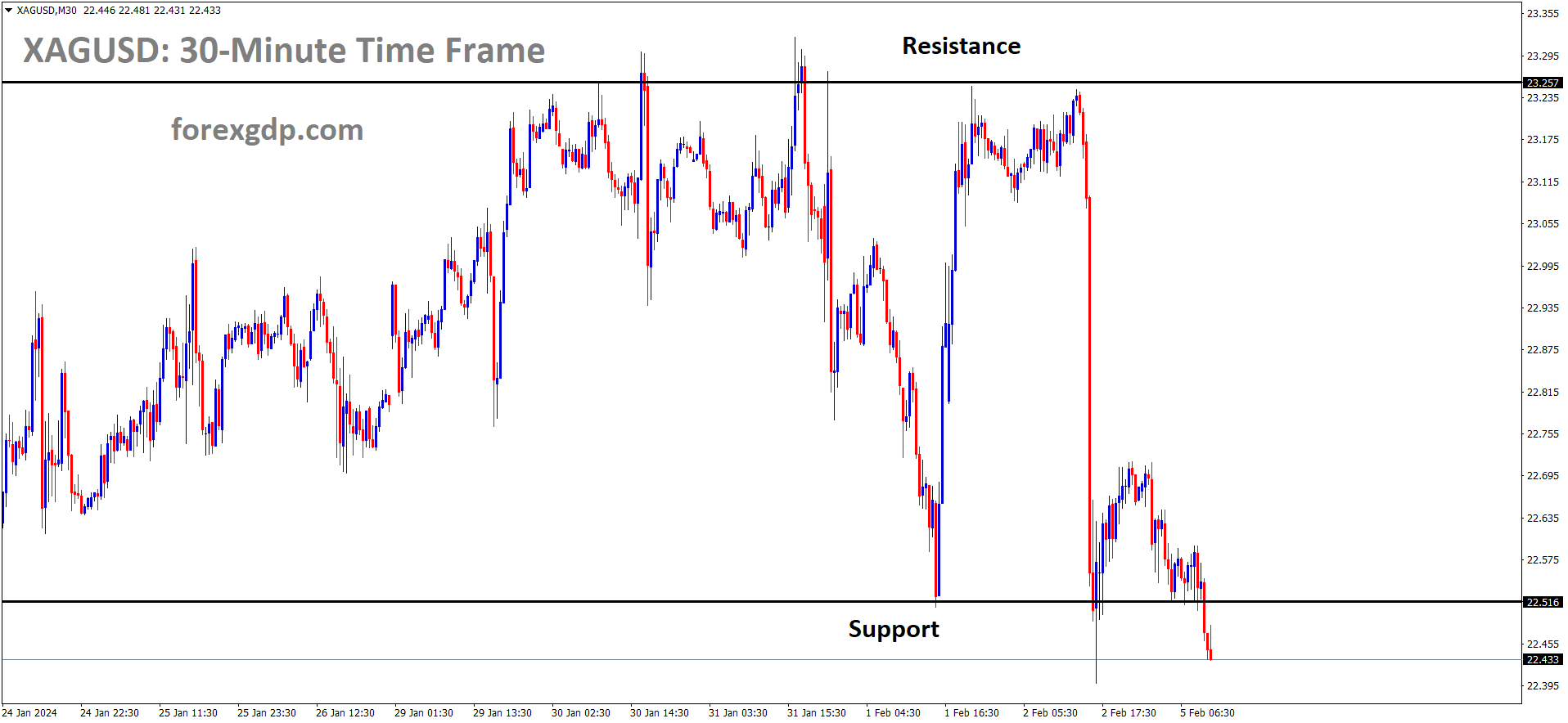
FED Powell’s speech on Sunday shows support for the US Dollar in the market. Rate cuts are not necessary in the near term, Wages and inflation have to cool down then only rate cuts.
Fed chair emphasized that a rate cut in the next March meeting is too early. US Nonfarm Payrolls for January increased to 353K, surpassing December’s 333K and exceeding expectations. Fed Chair Jerome Powell stated on Sunday that the central bank plans to cut interest rates three times this year but emphasized that a rate cut in the upcoming March meeting is likely too early, with expectations pointing to cuts in May or June. US Nonfarm Payrolls for January rose to 353K from December’s 333K (revised up from 216K), and the Unemployment Rate remained unchanged at 3.7%. Average Hourly Earnings increased to 4.5% YoY. Post-report, the likelihood of a March rate cut dropped to 19%, down from 38% a day ago, according to the CME FedWatch tool.
US national security adviser Jake Sullivan announced potential additional strikes in response to the Jordan drone attack, escalating tensions in the Middle East, potentially leading to safe-haven flows benefiting the USD. Market focus shifts to January US ISM Services PMI, expected to improve to 52.0 from December’s 50.6. Fed’s Raphael W. Bostic is scheduled to speak later on Monday, influencing trading opportunities around the US Dollar Index.
USDCAD Analysis:
USDCAD is moving in the Box pattern and the market has rebounded from the support area of the pattern
Middle east and Western countries clashed on the Red Sea, US and UK forces struck Four cruise ship missiles backed by Hamas and protected the Business ships in the Red Sea. Markets start the week cautiously, assessing geopolitical developments from the weekend. Geopolitical tensions rise as the US and UK conduct air strikes on Iran-backed Houthi group in Yemen, hitting at least 30 targets. Escalation follows Friday’s air assault on Iran-backed groups in Syria and Iraq, along with the Iranian Revolutionary Guard, in response to a drone strike that killed three US service members in Jordan. Yemen’s Houthi rebels vow to extend military operations and threaten retaliation against the latest US and UK strikes. US Central Command confirms a self-defense strike against a Houthi land attack cruise missile and targets four anti-ship cruise missiles in the Red Sea.
Canadian Dollar moved higher on the last Friday after the US jobs report came at higher than expected. This week Canadian Ivey PMI data and BoC Governor Tiff Mackhlem’s speech are scheduled.Market favor for the US Dollar intensifies following the release of NFP data, marking the largest figure in a year. Canadian economic data concluded on Wednesday; traders of the Canadian Dollar look forward to Ivey PMIs next Tuesday for further insights. Significant revisions were observed in the US Nonfarm Payrolls on the backend, contributing to the market dynamics. The Canadian Dollar shows broad strength on Friday, advancing against most major currencies, although the US Dollar takes the lead for the day, propelled by the highest US Nonfarm Payrolls (NFP) figure in a year. Canada is not featured on the economic calendar for Friday, and CAD investors eagerly anticipate next Tuesday’s release of the Canadian Ivey Purchasing Managers Index data. Additionally, Bank of Canada Governor Tiff Macklem is scheduled to make an appearance on Tuesday.
US NFPs printed at their highest level in a year, coming in at 353K in January and easily trouncing the forecast of 180K. December’s NFP also saw a drastic upside revision, from 216K to 333K. US Average Hourly Earnings in January also climbed, printing at 0.6% versus the forecast of 0.3% and the previous month’s 0.4%. YoY Average Hourly Earnings climbed to 4.5% for the year ending in January, compared to the forecast of 4.1% and the last print of 4.4%. The US Dollar surged across the entire FX market post-NFP, marking up gains against all of its major currency peers. The US Dollar is one of the best performers on the week and is in the green or flat across the board. The Canadian Dollar saw gains against most of its peers, but shed weight against the Greenback. CAD and USD vie for top spot on the week, but NFP beat is the Greenback’s clincher.
USDCHF Analysis:
USDCHF has broken the Descending channel in upside
Swiss Production data came at higher in January month, and GDP Data also came at higher in January month. But for Retail sales, wage growth is slower than expected. SNB rate cut is widely expected in September 2024. USDCHF Rises on Strong US Nonfarm Payrolls Data. Fed’s Powell Cautions Against March Rate Cuts.
Swiss National Bank Eyes Rate Cut in September 2024. USD gains support amid expectations that the Federal Reserve won’t cut rates in March, fueled by strong US employment data. US Nonfarm Payrolls report for January shows an addition of 353K jobs, surpassing expectations, while Average Hourly Earnings and Unemployment Rate also outperform.
EURCHF Analysis:
EURCHF has broken the Descending channel in upside
Fed Chair Jerome Powell cautions against premature rate cuts in March, emphasizing the need for a cautious approach given the current economic strength. Chicago Fed President Austan Goolsbee views robust US job growth as a sign of labor market resilience, not a reason to delay rate cuts. Swiss Manufacturing PMI indicates marginal production growth, with Swiss Real Retail Sales and Consumer Demand seeing a dip. Anticipation in the market suggests the Swiss National Bank might implement its first rate cut in September 2024, aligning with consensus expectations.
EURUSD Analysis:
EURUSD is moving in the Descending channel and the market has reached the lower low area of the channel
ECB Governing Council member Boris Vujcic said the rate cuts in the near term are not possible, the ECB has to consider the inflation effects and wages in the market.
EURUSD trades weakly around 1.0772, influenced by a stronger USD. Fed Chair Powell expresses that a rate cut in March is premature, citing doubts about inflation sustainably reaching 2%. US January Nonfarm Payrolls exceed expectations at 353K, well above the market forecast of 180K. The Unemployment rate remains unchanged, and wages experience a notable increase. Fed Chairman Jerome Powell states that a rate cut in March is premature, expressing skepticism about the FOMC’s confidence in inflation returning sustainably to 2% by then. Powell notes the appropriateness of rate cuts this year and openness to the possibility of rates falling from spring onwards. Discussion on easing the pace of quantitative tightening is slated for the March meeting. US Nonfarm Payrolls for January, reported by the US Bureau of Labor Statistics on Friday, surpass expectations at 353K, exceeding the previous reading’s 185K increase. The Unemployment Rate remains steady at 3.7%, and Average Hourly Earnings show firm growth, rising to 4.5% YoY in January from December’s 4.4%. ECB Governing Council member Boris Vujcic emphasizes the need to prevent second-round effects on inflation from wages before considering interest rate cuts. Investors focus on upcoming data, including German Trade Balance, January HCOB Composite PMI from Germany, Eurozone, and Spain. Additionally, the US ISM Services PMI is scheduled.
EURJPY Analysis:
EURJPY is moving in an Ascending channel and the market has rebounded from the higher low area of the channel
The Bank of Japan Dovish rates and no improvement on changing policy terms make the JPY weaker against counter pairs. War fears also weaken the Japanese Yen in the market. JPY Recovers on BoJ’s Hawkish Tilt and Geopolitical Risks Rising US Bond Yields Support USD, Offering Further Potential for the Pair JPY Bounces Back, Reaches Daily Peak Against USD Amid BoJ’s Hawkish Tone. BoJ’s Stance on Phasing Out Stimulus Supports JPY’s Rebound.Geopolitical Tensions and China Growth Concerns Boost JPY’s Safe-Haven Appeal
JPY Gains Haven Flows on Rising Geopolitical Risks – Daily Market Digest Optimism from China’s market stabilization pledge and upbeat US employment data fades amid geopolitical tensions, boosting the safe-haven Japanese Yen. China Securities Regulatory Commission vows to guide funds into the market and crack down on illegal activities, contributing to market unease. Strong US NFP data with 353K jobs added in January diminish hopes for a near-term Fed rate cut, shifting the May FOMC meeting probability to 70% from 90%. Geopolitical developments include reports of Hamas rejecting a Gaza ceasefire and Israel’s commitment to achieving war goals. Japan’s services sector shows robust growth, with au Jibun Bank Service PMI at 53.1 for January, the 17th consecutive month of expansion. Bank of Japan’s bullish outlook on inflation, driven by wage increases and service sector price growth, strengthens the case for an exit from negative interest rates. Anticipation for the US ISM Services PMI release, expected to improve from 50.6 to 52.0 in January, will influence USD/JPY dynamics alongside US bond yields and broader risk sentiment.
GBPUSD Analysis:
GBPUSD is moving in the Box pattern and the market has reached the support area of the pattern
The Bank of England Chief Economist Huw Pill said rate cuts in the near term are not necessary, once inflation has to come down in the UK is the major goal for the Bank of England. It created the fear of recession while long-term rates are higher in the UK. GBPUSD weakened as the US Dollar surged following strong US jobs data. US Nonfarm Payrolls for January exceeded expectations, adding 353K jobs compared to the anticipated 180K. Fed Chair Jerome Powell emphasized that initiating rate cuts in the March meeting is premature. BoE’s Huw Pill stated that the appropriate time for rate cuts is likely still in the future, suggesting a cautious approach GBP faces challenges against a strengthening USD, marked by an eight-week high in the US Dollar Index, driven by reduced expectations of a March rate cut by the Federal Reserve. Positive market sentiment supporting the USD is fueled by a robust US labor market report, with Nonfarm Payrolls adding 353,000 jobs in January, surpassing expectations. Average Hourly Earnings rose by 4.5%, exceeding anticipated and previous figures. Traders closely watch indicators like the ISM Services Employment Index for insights into the US labor market and potential monetary policy impacts.
Fed Chair Jerome Powell indicates a cautious approach, stating the March meeting is likely too soon for rate cuts. Powell emphasizes careful timing given the strong economy, requiring more assurance before considering rate cuts. BoE Governor Andrew Bailey avoids rate cut speculation, highlighting potential price pressures in the second half of the year and prioritizing managing high inflation over recession fears. BoE Chief Economist Huw Pill suggests the right time for BoE rate cuts is likely in the future, emphasizing the need for sufficient evidence and uncertainty regarding longer-term inflationary pressures.
AUDUSD Analysis:
AUDUSD is moving in the Descending channel and the market has fallen from the lower high area of the channel
Australian Trade Balance data came at lower than expected in January month. 10959M printed in January month versus 11764M in December month. RBA is expected to hold the interest rates at tomorrow’s meeting is widely expected.
Australian Dollar weakened due to a surge in the US Dollar following strong Nonfarm Payrolls. Australia’s Trade Balance decreased to 10,959M in January compared to the previous 11,764M. Chinese Services PMI dropped to 52.7 in January, down from the previous reading of 52.9. RBA is anticipated to maintain the cash rate at 4.35% in the upcoming Tuesday meeting. US Nonfarm Payrolls exceeded expectations by adding 353K jobs in January, surpassing the market consensus of 180K. AUD recovered intraday losses on Monday but faced challenges from strong US job data, leading to a rise in the USD and pressure on the AUD/USD pair.
S&P/ASX 200 Index retreated from last week’s high, impacting the AUD, especially in the miners and energy sectors. Australian Trade Balance for January reduced to 10,959M from the revised December figure of 11,764M. Judo Bank Composite PMI improved to 49 in January, with Services PMI rising to 49.1 from the previous 47.9. TD Securities Inflation (YoY) grew by 4.6%, down from the previous 5.2%, and Chinese Caixin Services PMI decreased to 52.7 from 52.9 in January. RBA expected to maintain the cash rate at 4.35%, and investors await insights from RBA Governor Michele Bullock’s speech.
USD Index reaches an eight-week high, supported by positive market sentiment after a robust US labor market report. US Nonfarm Payrolls added 353,000 jobs in January, surpassing the market consensus of 180,000. Average Hourly Earnings rose by 4.5%, exceeding expectations, and ISM Services Employment Index to be observed. Fed Chair Powell suggests March rate cuts are unlikely, emphasizing a cautious approach with confidence in the strong economy. Powell notes progress on inflation, considering potential earlier moves in the face of labor market weakness or convincing decreases in inflation.
Australian TD Securities Inflation increased by 0.3% in January, down from December’s 1.0%. ANZ Job Advertisements in Australia rose by 1.7% in January, surpassing the previous growth of 0.6%. Australian Imports grew by 4.8% in January, contrasting with the previous -8.4%, while Exports rose by 1.8%, compared to the 0.6% prior. US Average Hourly Earnings (MoM) for January exceeded expectations at 0.6%, up from December’s 0.4%. The US Unemployment Rate held steady at 3.7% in January, meeting the market consensus of 3.8%. January’s Labor Force Participation Rate in the US remained stable at 62.5%, according to the US Bureau of Labor Statistics. Michigan Consumer Sentiment Index improved to 79 in January, surpassing the expected 78.9 and December’s 78.8.
NZDUSD Analysis:
NZDUSD is moving in the Descending channel and the market has fallen from the lower high area of the channel
China’s Caixin Manufacturing PMI came at 52.7 in January month it is the 13th straight upside reading. But the NZ Dollar moved down after the Geopolitical tensions came at a higher priority than Chinese data. NZDUSD falls to a more than two-month low, influenced by various factors. Geopolitical tensions and mixed signals from China contribute to the downward pressure on the New Zealand Dollar.Strong US Nonfarm Payrolls data dashes expectations for an imminent Fed rate cut, supporting the US Dollar. China Securities Regulatory Commission pledges to prevent abnormal market fluctuations, intending to channel more medium- and long-term funds while cracking down on illegal activities like malicious short selling and insider trading. Despite the CSRC’s commitment, there are no specified details on their implementation plan. This announcement, coupled with geopolitical tensions, counterbalances recent optimism stemming from the People’s Bank of China reducing the reserve requirement ratio by 50 bps, injecting an expected CNY1 trillion into the economy. Hamas is reported to reject the Gaza ceasefire deal proposed in Paris. Israel’s Prime Minister, Benjamin Netanyahu, states that the country will not end the war until it achieves specific goals, including the elimination of Hamas, the return of all kidnapped individuals, and ensuring that Gaza does not pose a threat. US Central Command announces a self-defense strike against a Houthi land attack cruise missile and four anti-ship cruise missiles prepared to launch in the Red Sea.
Caixin’s data reveals China’s Services PMI at 52.7 for January, indicating expansion for the 13th consecutive month but has minimal impact on antipodean currencies. The USD reaches its highest level since December 11, supported by expectations of the Federal Reserve keeping interest rates higher for an extended period due to Friday’s positive US jobs report. The hawkish outlook supports a further increase in US Treasury bond yields, acting as a tailwind for the USD and potentially limiting upside for the NZDUSD pair. Market focus shifts to the US ISM Services PMI release, expected to influence the Greenback alongside broader risk sentiment. The fundamental backdrop suggests the path of least resistance for the currency pair is to the downside, and any attempted recovery may be short-lived.
Don’t trade all the time, trade forex only at the confirmed trade setups.
Get more confirmed trade setups here: forexgdp.com/buy/

